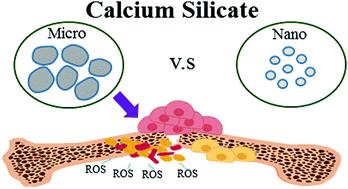当前位置:
X-MOL 学术
›
J. Mater. Chem. B
›
论文详情
Our official English website, www.x-mol.net, welcomes your
feedback! (Note: you will need to create a separate account there.)
In vitro comparisons of microscale and nanoscale calcium silicate particles.
Journal of Materials Chemistry B ( IF 6.1 ) Pub Date : 2020-06-12 , DOI: 10.1039/d0tb01202e Yun-Ru Huang,I-Ting Wu,Chun-Cheng Chen,Shinn-Jyh Ding
Journal of Materials Chemistry B ( IF 6.1 ) Pub Date : 2020-06-12 , DOI: 10.1039/d0tb01202e Yun-Ru Huang,I-Ting Wu,Chun-Cheng Chen,Shinn-Jyh Ding

|
Calcium silicate (CaSi) materials have been used for bone repair and generation due to their osteogenic properties. Tailoring the surface chemistry and structure of CaSi can enhance its clinical performance. There is no direct comparison between microscale and nanoscale CaSi particles. Therefore, this article aimed to compare and evaluate the surface chemistry, structure, and in vitro properties of microscale CaSi (μCaSi) and nanoscale CaSi (nCaSi) particles synthesized by the sol–gel method and precipitation method, respectively. As a result, the semi-crystalline μCaSi powders were assemblies of irregular microparticles containing a major β-dicalcium silicate phase, while the amorphous nCaSi powders consisted of spherical particles with a size of 100 nm. After soaking in a Tris–HCl solution, the amount of Si ions released from nCaSi was higher than that released from μCaSi, but there was no significant difference in Ca ion release between the two CaSi particles. Compared to microscale CaSi (μCaSi), nanoscale CaSi (nCaSi) significantly enhanced the growth and differentiation of human mesenchymal stem cells (hMSC) and inhibited the function of RAW 264.7 macrophages. In the case of antibacterial activity against Gram-negative Escherichia coli (E. coli) and Gram-positive Staphylococcus aureus (S. aureus), nanoscale nCaSi displayed a higher bacteriostatic ratio, a greater growth inhibition zone and more reactive oxygen species (ROS) production than microscale μCaSi. The conclusion is that nanoscale CaSi had greater antibacterial and osteogenic activity compared to microscale CaSi. Next generation CaSi-based materials with unique properties are emerging to meet specific clinical needs.
中文翻译:

微米级和纳米级硅酸钙颗粒的体外比较。
硅酸钙(CaSi)材料由于具有成骨特性,已被用于骨骼修复和生成。调整CaSi的表面化学和结构可以增强其临床性能。微米级和纳米级CaSi颗粒之间没有直接比较。因此,本文旨在比较和评估表面化学,结构和体外溶胶-凝胶法和沉淀法合成的微米级CaSi(μCaSi)和纳米级CaSi(nCaSi)颗粒的性能。结果,半结晶μCaSi粉末是包含主要的β-二硅酸钙相的不规则微粒的集合体,而非晶态nCaSi粉末则由尺寸为100 nm的球形颗粒组成。在Tris-HCl溶液中浸泡后,从nCaSi释放的Si离子的量高于从μCaSi释放的Si离子的量,但是两个CaSi颗粒之间的Ca离子释放没有显着差异。与微米级CaSi(μCaSi)相比,纳米级CaSi(nCaSi)显着增强了人间充质干细胞(hMSC)的生长和分化,并抑制了RAW 264.7巨噬细胞的功能。在对革兰氏阴性菌有抗菌活性的情况下纳米级nCaSi与微级μCaSi相比,大肠杆菌(E. coli)和革兰氏阳性金黄色葡萄球菌(S. aureus)具有更高的抑菌率,更大的生长抑制区和更多的活性氧(ROS)产生。结论是,与微米级CaSi相比,纳米级CaSi具有更大的抗菌和成骨活性。具有独特性能的下一代基于CaSi的材料正在出现,以满足特定的临床需求。
更新日期:2020-07-22
中文翻译:

微米级和纳米级硅酸钙颗粒的体外比较。
硅酸钙(CaSi)材料由于具有成骨特性,已被用于骨骼修复和生成。调整CaSi的表面化学和结构可以增强其临床性能。微米级和纳米级CaSi颗粒之间没有直接比较。因此,本文旨在比较和评估表面化学,结构和体外溶胶-凝胶法和沉淀法合成的微米级CaSi(μCaSi)和纳米级CaSi(nCaSi)颗粒的性能。结果,半结晶μCaSi粉末是包含主要的β-二硅酸钙相的不规则微粒的集合体,而非晶态nCaSi粉末则由尺寸为100 nm的球形颗粒组成。在Tris-HCl溶液中浸泡后,从nCaSi释放的Si离子的量高于从μCaSi释放的Si离子的量,但是两个CaSi颗粒之间的Ca离子释放没有显着差异。与微米级CaSi(μCaSi)相比,纳米级CaSi(nCaSi)显着增强了人间充质干细胞(hMSC)的生长和分化,并抑制了RAW 264.7巨噬细胞的功能。在对革兰氏阴性菌有抗菌活性的情况下纳米级nCaSi与微级μCaSi相比,大肠杆菌(E. coli)和革兰氏阳性金黄色葡萄球菌(S. aureus)具有更高的抑菌率,更大的生长抑制区和更多的活性氧(ROS)产生。结论是,与微米级CaSi相比,纳米级CaSi具有更大的抗菌和成骨活性。具有独特性能的下一代基于CaSi的材料正在出现,以满足特定的临床需求。









































 京公网安备 11010802027423号
京公网安备 11010802027423号